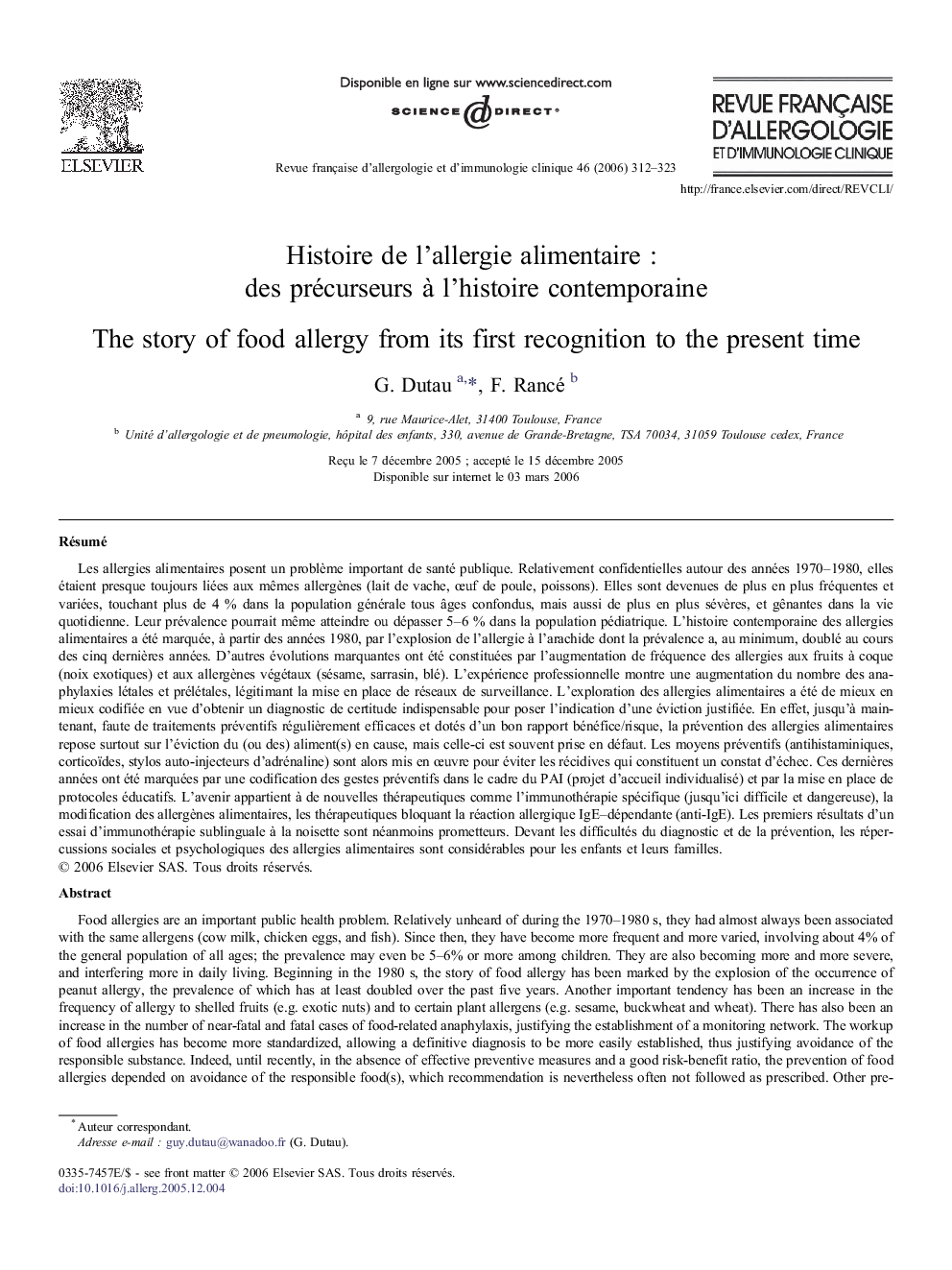| Article ID | Journal | Published Year | Pages | File Type |
|---|---|---|---|---|
| 2770616 | Revue Française d'Allergologie et d'Immunologie Clinique | 2006 | 12 Pages |
RésuméLes allergies alimentaires posent un problème important de santé publique. Relativement confidentielles autour des années 1970–1980, elles étaient presque toujours liées aux mêmes allergènes (lait de vache, œuf de poule, poissons). Elles sont devenues de plus en plus fréquentes et variées, touchant plus de 4 % dans la population générale tous âges confondus, mais aussi de plus en plus sévères, et gênantes dans la vie quotidienne. Leur prévalence pourrait même atteindre ou dépasser 5–6 % dans la population pédiatrique. L'histoire contemporaine des allergies alimentaires a été marquée, à partir des années 1980, par l'explosion de l'allergie à l'arachide dont la prévalence a, au minimum, doublé au cours des cinq dernières années. D'autres évolutions marquantes ont été constituées par l'augmentation de fréquence des allergies aux fruits à coque (noix exotiques) et aux allergènes végétaux (sésame, sarrasin, blé). L'expérience professionnelle montre une augmentation du nombre des anaphylaxies létales et prélétales, légitimant la mise en place de réseaux de surveillance. L'exploration des allergies alimentaires a été de mieux en mieux codifiée en vue d'obtenir un diagnostic de certitude indispensable pour poser l'indication d'une éviction justifiée. En effet, jusqu'à maintenant, faute de traitements préventifs régulièrement efficaces et dotés d'un bon rapport bénéfice/risque, la prévention des allergies alimentaires repose surtout sur l'éviction du (ou des) aliment(s) en cause, mais celle-ci est souvent prise en défaut. Les moyens préventifs (antihistaminiques, corticoïdes, stylos auto-injecteurs d'adrénaline) sont alors mis en œuvre pour éviter les récidives qui constituent un constat d'échec. Ces dernières années ont été marquées par une codification des gestes préventifs dans le cadre du PAI (projet d'accueil individualisé) et par la mise en place de protocoles éducatifs. L'avenir appartient à de nouvelles thérapeutiques comme l'immunothérapie spécifique (jusqu'ici difficile et dangereuse), la modification des allergènes alimentaires, les thérapeutiques bloquant la réaction allergique IgE–dépendante (anti-IgE). Les premiers résultats d'un essai d'immunothérapie sublinguale à la noisette sont néanmoins prometteurs. Devant les difficultés du diagnostic et de la prévention, les répercussions sociales et psychologiques des allergies alimentaires sont considérables pour les enfants et leurs familles.
Food allergies are an important public health problem. Relatively unheard of during the 1970–1980 s, they had almost always been associated with the same allergens (cow milk, chicken eggs, and fish). Since then, they have become more frequent and more varied, involving about 4% of the general population of all ages; the prevalence may even be 5–6% or more among children. They are also becoming more and more severe, and interfering more in daily living. Beginning in the 1980 s, the story of food allergy has been marked by the explosion of the occurrence of peanut allergy, the prevalence of which has at least doubled over the past five years. Another important tendency has been an increase in the frequency of allergy to shelled fruits (e.g. exotic nuts) and to certain plant allergens (e.g. sesame, buckwheat and wheat). There has also been an increase in the number of near-fatal and fatal cases of food-related anaphylaxis, justifying the establishment of a monitoring network. The workup of food allergies has become more standardized, allowing a definitive diagnosis to be more easily established, thus justifying avoidance of the responsible substance. Indeed, until recently, in the absence of effective preventive measures and a good risk-benefit ratio, the prevention of food allergies depended on avoidance of the responsible food(s), which recommendation is nevertheless often not followed as prescribed. Other preventive measures (antihistamines, corticosteroids, adrenalin auto-injectors) are then adopted to avoid recurrences, which can be considered as evidence of treatment failure. Recent years have been marked by standardization of preventive measures based on the Project of Individual Care and by the establishment of educational protocols. The future may see the development of specific immunotherapy (until now, difficult and dangerous), modification of food allergens, and treatments that block IgE-dependant allergic reactions. For example, the preliminary results of a clinical trial of sublingual immunotherapy with hazelnut appear to be promising. Considering the difficulty of diagnosis and prevention, the social and psychological repercussions of food allergies are considerable for both children and their families.
